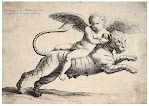We took these shots of the coast from
Trinidad Head, which has a nice trail going all the way from the beach to the summit. It was a pretty good climb, but well worth it--gorgeous all the way, with interesting vegetation and lots of places to stop and enjoy the view. It's windy as hell, and cold, but that only made the climb more fun.
When we sat down for a few minutes to watch the surf, we were lucky enough to see a pair of whales at play. Apparently, Trinidad is quite the whale watching spot, though we didn't know that. The good thing about being lazy tourists who never bother researching our destinations ahead of time is that we're often pleasantly surprised, and never disappointed. If we'd trudged up that cliff expecting to see whales and hadn't, we'd have been irritated and let down. Since we weren't looking for them, the whales were like a little miracle just for us.



This is a view in Redwood National Park, along the the road that leads to the Tall Trees Grove. My photo, as usual, doesn't do it justice. It's an amazing vista. You feel as if you are floating above the ocean on a carpet of trees. I kept hoping to see a raptor soaring below us, since the late morning air was warming up, creating the updrafts they like to glide along. None appeared, though there were lots of passerines and butterflies, as well as little lizards crawling over the rocks nearby.

The park is heavily managed, not really remote or wild, but they don't make it very easy for you to get to the grove where the biggest redwoods are. You have to get a permit at the park station, which provides the combination for a gate that blocks access to an unpaved road. You drive several miles, dodging the ruts, to get to a trail where you hike down to the tall trees--"down" being the operative word. The trailhead is 800 feet above the grove, so the 1.5 mile walk is all downhill. There's a loop through the grove that's about a mile long, and then you get to hike back up the same way you came. For someone in decent shape, it's just a pleasant, slightly demanding hike, but I'm sure there are people who get down there and have trouble getting back up. Although it was a beautiful Sunday morning, we only met a handful of other visitors.
The top and bottom photos below were taken in the Tall Trees Grove, the other two along the trail leading down to it. I wish they gave a better sense of the beauty of the place. The redwoods are stunning, but there are all kinds of other flora, especially ferns, and probably a dozen varieties of moss. There's a beautiful clover that is colored brilliant fuschia on the underside of its leaves. And the smell is incredible. Imagine the most exquisite
fougere, with a touch of cold ocean air. It was very strange to come back to the heavy, slightly dank air of the Tennessee woods after breathing the crystalline air along the coast.




We spent a very happy few hours among the redwoods, though I came away feeling the same grief I always do when I visit the little bits of nature we've caged for our enjoyment. I feel the same way in the parks here at home. They're beautiful in exactly the same way a tiger in a zoo is beautiful. And tragic in the same way, too.











.jpg)

































